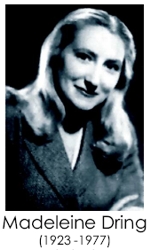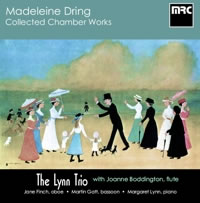Madeleine
Dring Collected Chamber Works
Buy this album now CD: £12.00 + p&p |
| MRC Classical - Catalogue & Profile Page |
| Track Listing | |
| Trio for Flute, Oboe and Piano [10:34] | |
| 1 | Allegro con brio |
| 2 | Andante semplice |
| 3 | Allegro giocoso |
| 4 | Polka for Flute and Piano [02:03] |
| 5 | Italian Dance [02:11] |
| Colour Suite [10:49] | |
| 6 | Pink Minor |
| 7 | Red Glory |
| 8 | Yellow Hammers |
| 9 | Blue Air |
| 10 | Brown Study |
| 11 | Danza Gaya [02:21] |
| Three Piece Suite [12:26] | |
| 12 | Showpiece |
| 13 | Romance |
| 14 | Finale |
| Trio for Oboe, Bassoon and Keyboard [17:23] | |
| 15 | Drammatico |
| 16 | Dialogues (Andante sostenuto) |
| 17 | Allegro con brio |
This is delightful. Madeleine Dring was a very gifted artist — composer, singer, pianist and actress — whose music is well written, immediately communicative and attractive; the work of a composer who knows precisely what she could do, and did it to the best of her considerable ability. Her sudden death in I977, at the age of 54, robbed Britain of one of its most admirable composers, yet her music remains little known except to enthusiasts and performing musicians (her husband was the oboist Roger Lord). There are four main works in this first rate collection alongside three miniatures. Dring’s command of her craft and of her splendid material are admirable qualities, and if her art can be compared with composers of a more established school, Françaix and Poulenc come most readily to mind. The Trios (for flute, oboe and piano and for oboe, bassoon and harpsichord or piano – the latter on this disc) are so attractive that, like everything here, they will continue to give pleasure for years to come, This is the kind of music that will never fade; subtle, cleverly written and designed to enhance the listener's pleasure without patronising anyone. The performances are exemplary and the recordings are excellent. Robert Matthew-Walker; International Record Review
 From
an early age it was clear that Madeleine Dring was unusually gifted.
Born in London in 1923, to parents who were themselves competent amateur
musicians, her innate talents were nurtured in the convivial atmosphere
of a household fond of entertaining family and friends around the parlour
piano. She won a Junior Exhibition to the Royal College of Music at the
age of ten, and continued on to fulltime studies and a lifelong association
with the College - a bond which she recognized as being the most significant
influence on her musical life. Dring's teachers included Lillian Gaskell
(piano), Topliss Green (singing), and Herbert Howells and Ralph Vaughan
Williams for composition. Not content with 'three strings to her bow',
she also studied drama and mime - forms of theatre which she loved, and
in which she participated enthusiastically as writer, composer, actor,
singer and pianist. Her wide range of interests and achievements were
born of an exceptionally creative and highly original spirit.
From
an early age it was clear that Madeleine Dring was unusually gifted.
Born in London in 1923, to parents who were themselves competent amateur
musicians, her innate talents were nurtured in the convivial atmosphere
of a household fond of entertaining family and friends around the parlour
piano. She won a Junior Exhibition to the Royal College of Music at the
age of ten, and continued on to fulltime studies and a lifelong association
with the College - a bond which she recognized as being the most significant
influence on her musical life. Dring's teachers included Lillian Gaskell
(piano), Topliss Green (singing), and Herbert Howells and Ralph Vaughan
Williams for composition. Not content with 'three strings to her bow',
she also studied drama and mime - forms of theatre which she loved, and
in which she participated enthusiastically as writer, composer, actor,
singer and pianist. Her wide range of interests and achievements were
born of an exceptionally creative and highly original spirit.
Dring's compositions were generally small in scale, for she was most at ease in the intimate world of chamber music. Her songs, dances and idylls were exquisitely crafted miniatures which belonged to a post-war era when light music was immensely popular. By the time of her sudden death in 1977, tastes had already changed and her lighter style of music had become unfashionable. Fortunately, in recent years, an interest in her music is stirring again, and it is to be hoped that she will once more receive the recognition that she so richly deserves. This album opens with one of Madeleine Dring's most popular chamber works - the Trio for Flute, Oboe and Piano (1968), which was originally composed for the ensemble Musica da Camera. The idiom is reminiscent of the music of Poulenc, especially in the tongue-in-cheek character of the final movement, complete with a romping cadenza for the flute and oboe. The idyllic slow movement brings her lyrical gifts to the fore, the haunting melody at the beginning is tinged with nostalgia and a certain wistfulness.
A number of Madeleine Dring's chamber compositions feature the oboe (her husband, Roger Lord, is a world-renowned player). The Italian Dance (1960) is an excellent example of her ability to capture the spirit of the dance form, in this case the Tarantella, which she infuses with her own characteristic harmonic twists. The Polka (1962) was also originally for oboe and piano but is presented here in her alternative arrangement for flute and piano. It is a whimsical piece in which the melody flies off in the most unlikely directions, ending up in totally unexpected keys. Danza Gaya (1965), on the other hand, was re-arranged for oboe and piano from the original two piano version. This is an exotic rhumba full of sunshine and gaiety, with subtle changes of rhythm, texture and accompaniment throughout.
The piano was Dring's favoured instrument - nearly every piece she composed included it, and it was to serve as her main vehicle of musical expression throughout her life. She wrote a substantial amount of music for solo piano, piano duet and two pianos, of which the most widely appealing are the rhythmic studies from her Colour Suite (1963). Each of the five studies is an ingenuous invention on a jazzy motif associated with a particular colour, namely, C major - red, D major - yellow, F major - brown, G minor - blue and A minor - pink. As a child, Dring used to colour the keys of the parlour piano as an aide memoir.
The title of the penultimate work - Three Piece Suite - is indicative of the dry humour that often pervades Dring’s work. This launches with the driving piano chords of Showpiece, starting in 7/8 and working through a diversity of time signatures, before ending triumphantly in a bold 3/4 statement. The second movement, Romance, joins in stark contrast as a gentle, haunting melody in waltz time that perfectly encapsulates and defines the nostalgia-tinged writing that is so characteristic of Dring. The work ends with Finale - a characterful concoction of oboe and piano fragments that interweave and chatter, bringing the work to a delicate close with a masterfully understated section marked più lento e dolce.
The final work on this album was conceived for oboe, bassoon and harpsichord and premiered by the Athenaeum Ensemble in 1971. The choice of the harpsichord and the declamatory style of the opening movement give a clue to possible new explorations, and indeed, each of the three movements inhabits a different sound world. The first movement has the elements of a march but its constantly shifting meters prevent it from settling down. The middle movement entitled Dialogues is, in contrast, meditative and almost stark, focusing on pairs of long unfolding lines. The final movement utilises spiky chords and irregular meters topped by (vaguely jazzy) angular melodies, and capped by a final section which simulates the clanging of church bells. Subsequent performances have established that the harpsichord part works particularly well on the piano, and it is this variant which has been recorded here. We hope you find these few collected chamber works of Madeleine Dring as enjoyable to listen to as we did in recording them.
©2001 Margaret Lynn/©2008
David Finch
THE LYNN TRIO
Pianist Margaret Lynn, oboist Jane Finch and bassoonist Martin Gatt came
together in 2000 to form The Lynn Trio many years before. Margaret's
penchant for wind chamber music has led to performances with artists
such as Peter Lloyd, John McCaw and the late Anthony Camden. She was
Associate Dean of Music at the Hong Kong Academy for Performing Arts
for many years and currently serves as Academic Consultant. Jane Finch
has worked as a freelance oboist with the BBC Philharmonic, the Bournemouth
Symphony Orchestra, the Bournemouth Sinfonietta, and the Northern Sinfonia.
As a soloist and chamber musician she has performed extensively throughout
the UK, appearing in prestigious venues such as the Purcell Room and
Wigmore Hall, and has broadcast for BBC Radio. Martin Gatt has been
principal bassoonist with the London Philharmonic Orchestra, the English
Chamber Orchestra, the Academy of St. Martin-in-the-Fields, the London
Sinfonietta, and the London Symphony Orchestra, and has performed and
recorded as soloist and chamber musician all over the world. He is
a Fellow of the Guildhall School of Music and Drama and also of the
Royal College of Music in London where he is Professor of Bassoon
JOANNE BODDINGTON
Flautist Joanne Boddington started her studies at the Royal College of
Music under Edward Walker and Sebastien Bell. During postgraduate studies
at Guildhall she was appointed to her first position with the BBC Scottish
Symphony Orchestra. Six years later she joined the Bournemouth Symphony
Orchestra as principal piccolo, moving to the Birmingham Royal Ballet
and then the BBC Philharmonic as principal piccolo and co-principal
flute. Joanne now plays with the Hallé Orchestra, for which
she undertakes a great deal of principle work, and teaches at the Royal
Northern College of Music
| CREDITS |
| Frontispiece “Jane, you must get the children home” by Helen Bradley (1900-1979) Reproduced by kind permission of Helen Bradley Prints Ltd. ©2001 www.helenbradley.co.uk |
 MRC
Classical is a small, independent record label dedicated to making
fine classical recordings. We aim for a natural and detailed sound
using carefully chosen equipment and minimal microphone placement.
For further information regarding our recording facilities or releases
please email us directly at: mrcclassical@talktalk.net MRC
Classical is a small, independent record label dedicated to making
fine classical recordings. We aim for a natural and detailed sound
using carefully chosen equipment and minimal microphone placement.
For further information regarding our recording facilities or releases
please email us directly at: mrcclassical@talktalk.net |
Balance Engineer: Dave Finch Recorded in high resolution digital sound
at St. George's, Bristol, November 2008 |
| Instruments: | Bassoon, oboe & Piano trio + flute |
| Genre: | Classical |
| Format: | Audio CD |
| Our Ref: | A0284 |
| MCPS: | MRCD1R |
| Label: | MRC Classical |
| Year: | 2009 |
| Origin: | UK |




